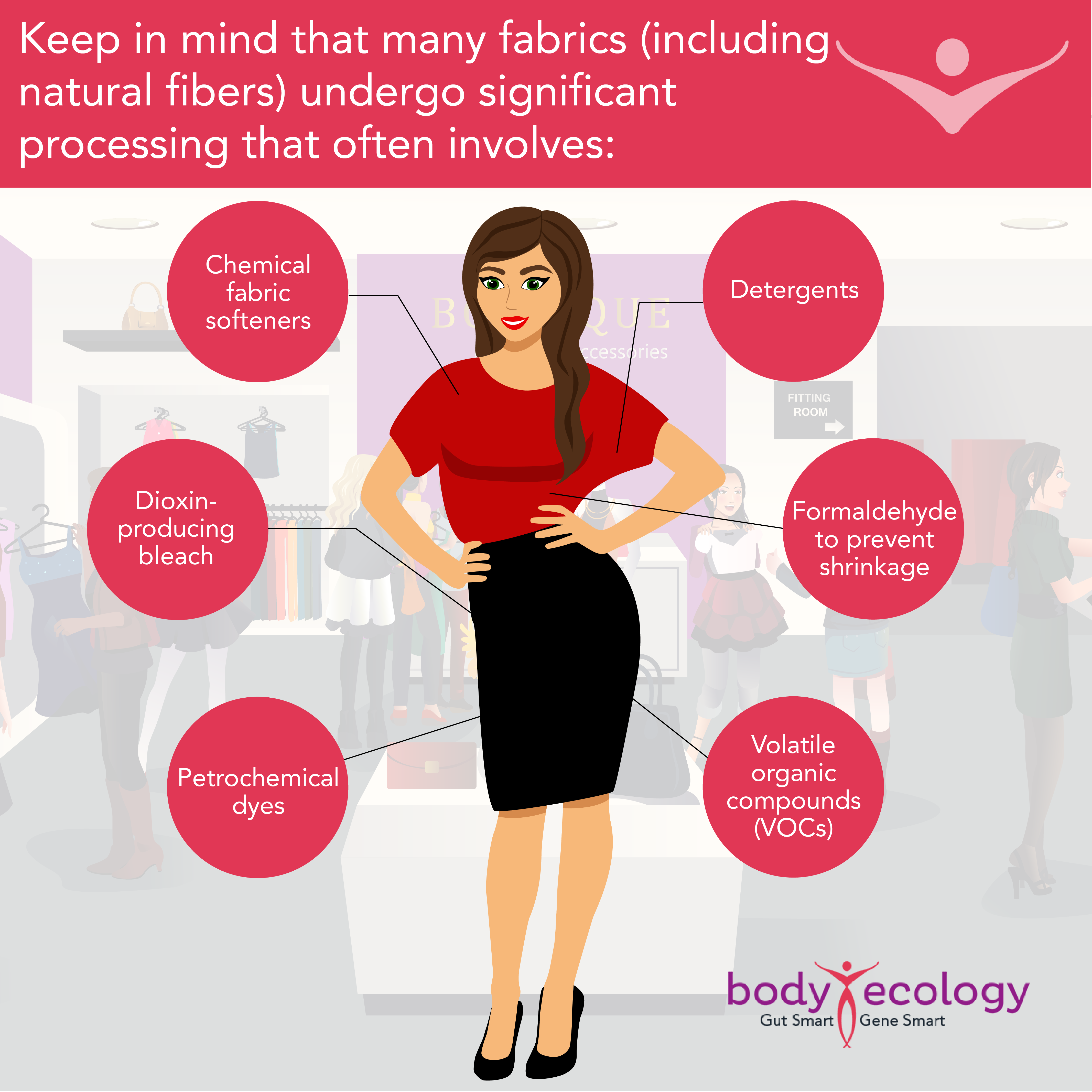
The top 6 fabrics you should avoid wearing (and why)
Every day and night, we’re surrounded by fabrics. From the clothing we wear to the sheets on our beds to upholstery on our furniture or car seats, these are the fabrics of our lives.
Fabrics are around us nearly all the time, but did you know that your material choices could either help or harm your health?
We’re living in a material world
Not that long ago, people stuck to the natural fabrics: wool, cashmere, cotton, silk, linen, and hemp.
But if you take a look at your clothing labels today, you’re likely to find materials like rayon, polyester, acrylic, acetate, and nylon. On top of that, your shirts and slacks may be treated to be wrinkle-free or stain-resistant.
These technological advances in fabrics may make our lives simpler, but at what cost?
Chemically treated synthetic and natural fabrics are a source of toxins that may adversely affect your health and the health of the planet.
Steer clear of these 6 toxic fabrics
Here’s our shortlist of fabrics to avoid:
1. Acetate. Both acetate and triacetate are manufactured from wood fibers called cellulose and undergo extensive chemical processing in order to produce the finished product.
2. Acrylic. Acrylic fabric is made of polyacrylonitriles and may have potentially strong links to cancer, especially in women.1
3. Nylon. Made from petroleum, nylon fabric is often given a permanent chemical finish that may be harmful.
4. Polyester. Polyester is pretty much the worst fabric you can buy. It’s made from synthetic polymers, derived from esters of dihydric alcohol and terephthalic acid, and may release hundreds of millions of microfibers into the environment per person each year through washing.2
5. Rayon. Rayon is recycled wood pulp that must be treated with chemicals like caustic soda, ammonia, acetone, and sulphuric acid to survive regular washing and wearing.
6. Anything labeled static-resistant, stain-resistant, permanent press, wrinkle-free, stain-proof, or moth-repellent. Many of the stain-resistant and wrinkle-free fabrics are treated with perfluorinated chemicals (PFCs), like Teflon; these pollutants have been detected in humans and marine animals.3

These additives are potentially toxic to the human body, may contain heavy metals, and can pollute our environment.4-7
Need a few tips on living in tune with your body? Claim your free guide to getting started on the Body Ecology Diet.
Stay safe by wearing 7 natural fabrics
If you’re chemically sensitive or just want to surround yourself with healthy fabrics, listen to Doris Brunza — a fashion designer who worked in the Garment District in New York City for 20 years. She knows about finding natural fabrics that don’t cause reactions because she’s chemically sensitive.
Brunza points out that nearly all fabrics, including organic fabric, are treated with chemicals at some point during their processing.8 Still, some choices are better than others.

Brunza also advises people to buy high-quality European garments made with the finest fabrics (for those who can afford it).
Expensive clothing may seem overpriced, but the quality of the raw materials is superior. The fibers can be woven into beautiful fabrics that are soft and strong, requiring little chemical processing to make them suitable for you, the consumer.
These garments last you for years, which makes them a cost-effective and sustainable purchase in the long run. Buying vintage or second-hand can also be a smart, sustainable act.
Remember to avoid chemical dry cleaning whenever possible and wash your clothes in a “green” detergent. We love the refillable laundry detergent provided by our friends at MyGreenFills, a non-toxic laundry subscription service.
Reducing your toxic load by watching what you’re putting into your body and developing immune-boosting strategies, like sipping probiotic drinks and eating fermented vegetables daily, can have a tremendous impact on creating a thriving inner ecosystem. Organic food, pure water, and natural or organic clothing can work together to enhance your wellbeing and quality of life.
REFERENCES:
- 1. Labrèche F, Goldberg MS, Valois M, et alPostmenopausal breast cancer and occupational exposures. Occupational and Environmental Medicine 2010;67:263-269.
- 2. Francesca De Falco, Mariacristina Cocca, Maurizio Avella, Richard C. Thompson. Microfiber Release to Water, Via Laundering, and to Air, via Everyday Use: A Comparison between Polyester Clothing with Differing Textile Parameters. Environmental Science & Technology, 2020; DOI: 10.1021/acs.est.9b06892.
- 3. Jennifer M. Keller, Lily Ngai, Joanne Braun McNeill, Lawrence D. Wood, Kelly R. Stewart, Steven G. O’Connell, John R. Kucklick. Perfluoroalkyl contaminants in plasma of five sea turtle species: Comparisons in concentration and potential health risks. Environmental Toxicology and Chemistry, 2012; 31 (6): 1223 DOI: 10.1002/etc.1818.
- 4. Mohan Manikkam, Rebecca Tracey, Carlos Guerrero-Bosagna, Michael K. Skinner. Dioxin (TCDD) Induces Epigenetic Transgenerational Inheritance of Adult Onset Disease and Sperm Epimutations. PLoS ONE, 2012; 7 (9): e46249 DOI: 10.1371/journal.pone.0046249.
- 5. Sara Ortega-Atienza, Blazej Rubis, Caitlin McCarthy, Anatoly Zhitkovich. Formaldehyde Is a Potent Proteotoxic Stressor Causing Rapid Heat Shock Factor Protein 1 Activation and Lys48-Linked Polyubiquitination of Proteins. The American Journal of Pathology, 2016; DOI: 10.1016/j.ajpath.2016.06.022.
- 6. Rovira J, Nadal M, Schuhmacher M, Domingo JL. Human exposure to trace elements through the skin by direct contact with clothing: Risk assessment. Environ Res. 2015 Jul;140:308-16. doi: 10.1016/j.envres.2015.03.032. Epub 2015 Apr 16. PMID: 25889781.
- 7. T. Karl, M. Striednig, M. Graus, A. Hammerle, G. Wohlfahrt. Urban flux measurements reveal a large pool of oxygenated volatile organic compound emissions. Proceedings of the National Academy of Sciences, 2018; 201714715 DOI: 10.1073/pnas.1714715115.
- 8. Brunza, Doris. “Finding Tolerable Clothing or Fabric.” The Human Ecologist, Fall 1992.









